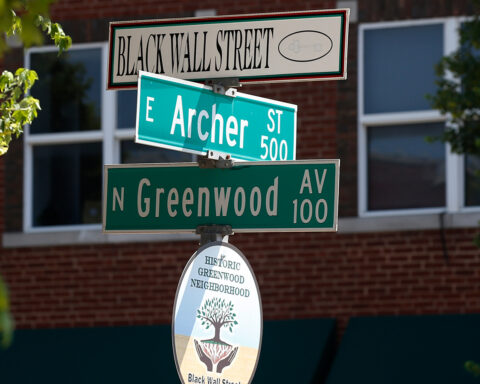Originally a narrow, mostly unpaved road that zigzagged between farming communities, old Route 7 ran more or less diagonally between Tulsa and the state capital, making it one of the busiest highways in Oklahoma in the early years of statehood.
Allen Threatt, a homesteader who came from Alabama sometime in the early 1900s, owned 160 acres of red dirt near the small town of Luther, along Route 7 half an hour northeast of Oklahoma City. And he capitalized on the highway traffic by opening a small filling station, where he not only sold gas but offered produce from his farm.
The spot became even busier in 1926, when the state highway became part of the federal government’s new Route 66, connecting Chicago and Los Angeles and bringing travelers from all across the United States.
The Threatt Filling Station, as far as Route 66 historians can tell, was the only Black-owned and -operated gas station on the legendary Mother Road during the Jim Crow era, guaranteeing that almost every Black traveler would stop there, because they weren’t always welcomed at other businesses along the way.
“Some of the other surrounding cities were ‘sunset communities,’” meaning Blacks were told not to be seen in town after dark, says C. David Threatt, Allen Threatt’s grandson who now lives in Maryland. “Everybody would stop and get gas, but particularly people of color, because they would feel safe. Sometimes they would even pull around to the backside of the property and spend the night in their cars, because they couldn’t stay in hotels.”
The business expanded over time to include a café, a bar and an outdoor stage for entertainment. Threatt even built a small baseball park nearby for the Negro Leagues.
“I remember when I was a kid, it was a gathering place for the whole community, especially on holidays,” David says. “The Fourth of July was a biggie. They would string lights in the trees and bring all the tables and chairs outside, and everybody would just have a good ol’ time.”
The filling station supported Threatt’s 11 children and made him one of the most successful and respected businessmen in town. The local newspaper reported that “silence fell on the whole community” when he died Dec. 8, 1950, at age 61.
Family members kept the station open for a while, but it has now been vacant for several decades. And the National Trust for Historic Preservation recently listed the site as one of America’s 11-Most Endangered Historic Places.
The sandstone walls seem to be as sturdy as ever, “a testament to the work that was done back in the 1910s,” David says. But a structural inspection last year found more than $200,000 in needed repairs, including a new roof and upgrades to the plumbing and electrical systems.
David and other descendants of the original owner have established the Threatt Family Foundation to raise the money and reopen the filling station as an interpretive center and museum, hopefully in time for the Route 66 centennial in 2026.
“It’s our little piece of history,” David says. And it’s a piece worth saving.





